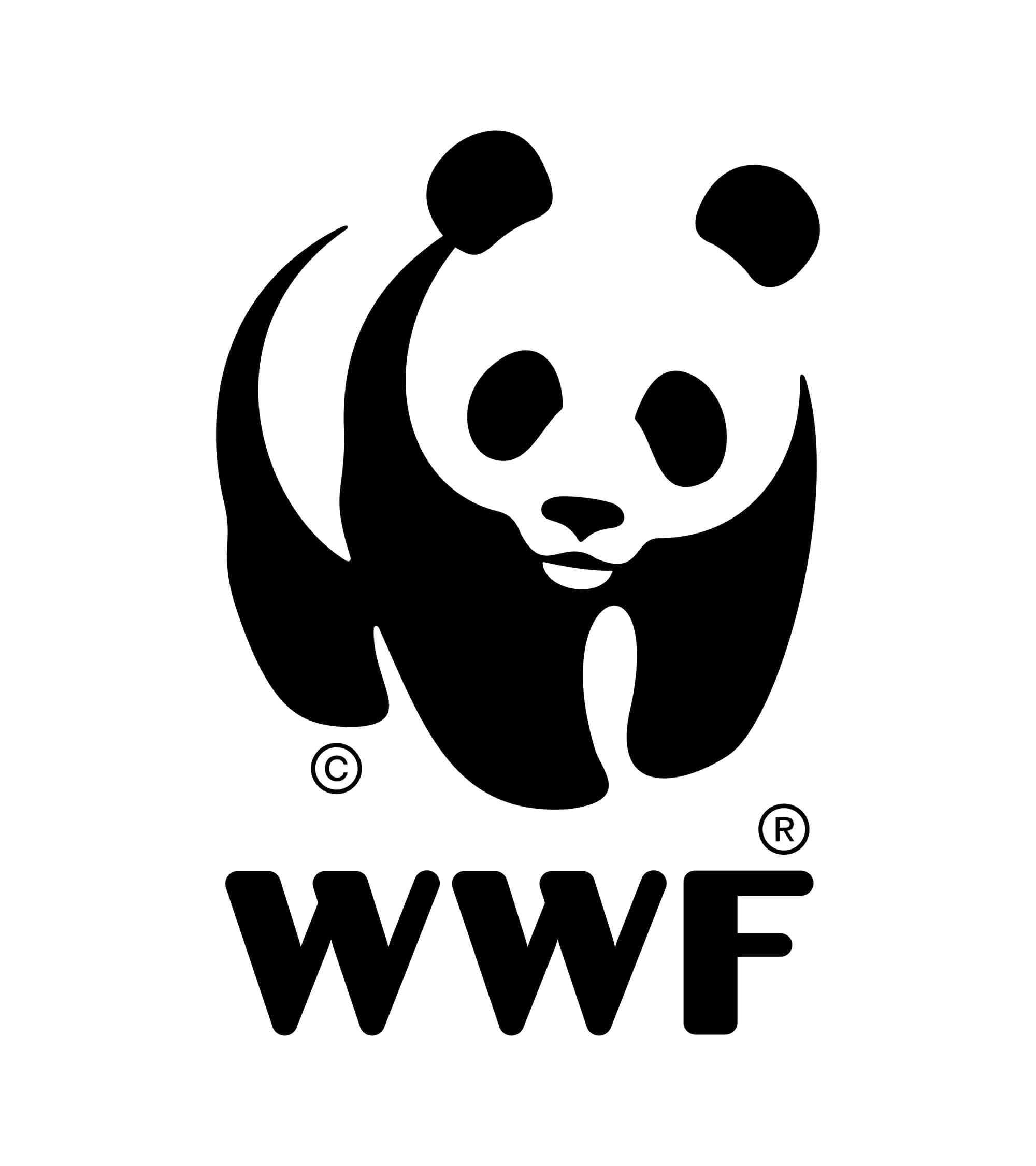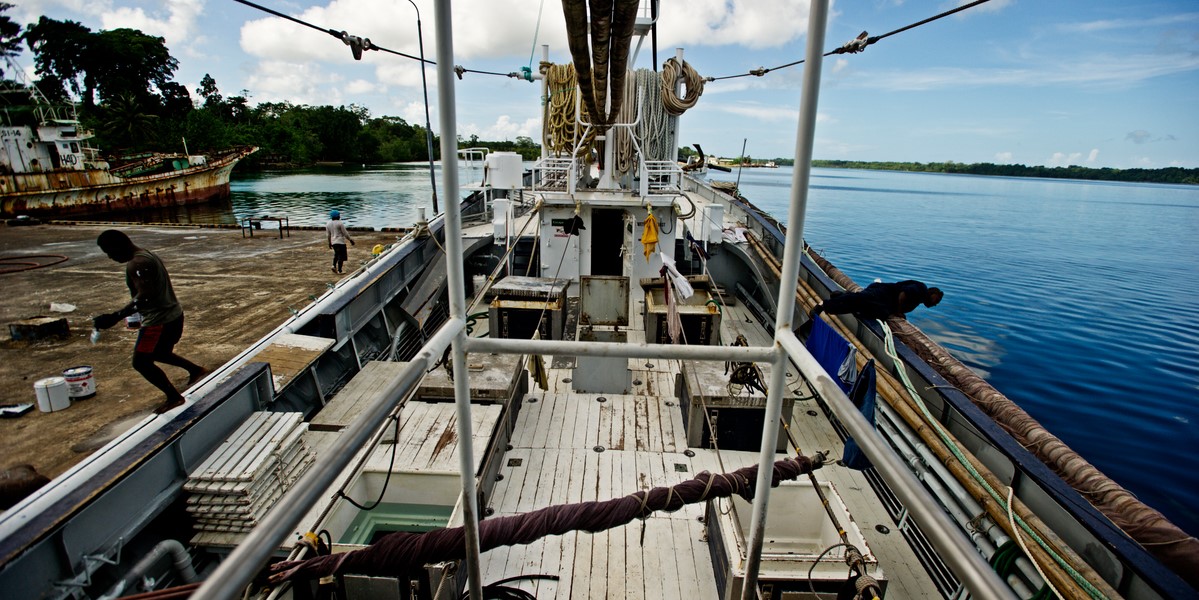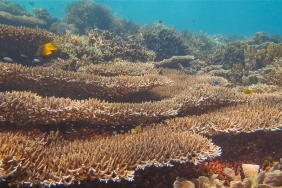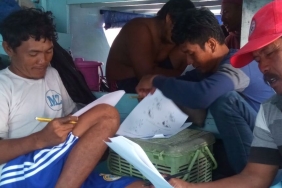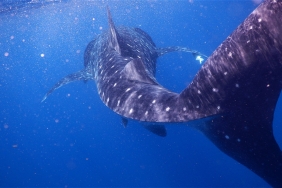HUHATEI: CATCHING GEAR WITH A MYRIAD OF BAIT
Dwi Ariyogagautama or Yoga has worked at WWF Solor Alor Project as Fisheries Officer for almost three years. Together with other WWF team, he tries to develop responsible and sustainable fisheries, especially for tuna fisheries. This graduate of Marine Science, Diponegoro University, actively involves in scientific diving club namely Marine Diving Club (MDC). Complete Profile...
By Dwi Ariyogagautama
Huhatei or often known as Skipjack pole and line is one of the methods of mass catching. In Flores Timur district, it is recorded that the number of fleets using this catching gear is amounting to 79 huhatei ships with the size of 6-30 GT, operating each year in the waters of Flores Sea and Savu Sea.
The ships used are different from fishing vessels in general. Huhatei ships have water sprinklers and a hold to store live bait; therefore, the circulation of water in the hold has to keep running by keeping the ship moving. So, it is not surprising if the fuel cost needed by this ship for one trip can spend 50% of the total operational cost which amounting to five million rupiah for a 6-30 GT huhatei fleet.
Huhatei fishhook is generally targeting Skipjack and Tuna fishes during the operation, but it also often catches baby tuna, either intentionally or unintentionally (bycatch). A 6-30 GT huhatei fleet has an accommodating capacity from 1.5 to 6 tons. In Flores Timur district, the huhatei ships operating during tuna season often turn to handline fishing to catch yellow-fin tuna because its selling price is higher than skipjack fish.
The operation of this method requires at least 14-18 workers in one huhatei ship; comprising of one captain, one fish expert (boi-boi), 10-14 anglers, and two crew members. When the Huhatei ship sails, a boi-boi determines the direction of the ship; when it discovers a group of skipjacks playing on the surface, the boi-boi will throw live bait to the group while directing the captain of the ship to make efficient the live bait thrown by the anglers in the front of the deck.
Huhatei fishing bait
The most determining factor of huhatei fishing is the availability of live bait. In Flores Timur district, they generally use the goldstripe sardinella fish (Sardinella gibbosa) and only some of them use the Indian scad fish. One trip requires at least 3-6 buckets or 60-90 kg, which contain approximately 5,000 goldstripe sardinella or Indian scad fishes in each bucket. In Flores Timur, fishermen or fishing companies can directly buy the bait in the floating fishing spots in some areas within the district.
However, as the number of huhatei fleets operating in Flores Timur district increasing, the number of live bait becomes more difficult to get. This is also experienced by companies located in Larantuka. Mangrove habitat along the Flores Timur coast that has been the nursery ground for goldstripe sardinella fish cannot contain the demand from huhatei ships. In 2011, the fishing companies in Larantuka have started to buy live bait from Lembata district. It is unfortunate if we don’t aware that the goldstripe sardinella fish as the main source of bait in Huhatei activities will become the fisheries problem in Flores Timur district in the future.
Huhatei Catching Areas
The listed catching areas for huhatei fishermen in Flores Timur district are in the waters of Flores Sea and Sawu Sea, both by relying on FADs and searching for groups of Skipjack fish in the off-shore water. However, the intensifying activities of skipjack fish catching in each trip forces the fishermen to heed the regulation on the catching areas that are allowed in their business license (SIUP). The FADs found in the waters of Flores Timur district are no longer producing sufficient amount of fishes as expected by fishing companies in certain seasons.
It is known that since 2010 a conflict has occurred between the fishermen in Balauring village, Lembata district and the huhatei ships from Flores Timur district. The illegal fishing has occurred in the FADs of Balauring fishermen, conducted either silently or openly in front of tuna fishing boats; at least 30-50 cases are found annually in this area.
Lembata district Sea Surveillance unit has caught at least four huhatei ships operating in Lembata district area and since 2011, the DKP Office of Lembata district has no longer provided andon (outsider) permit for ships from other districts to conduct fishing activities in the Lembata waters.
Regulations on fisheries catching area in archipelagic area like in Nusa Tenggara Timur have some challenges; such as the distance between adjacent districts, fishermen having mutual cultural and kinship ties, and the types of fish stocks that migrate seasonally between the waters of Flores Timur district and Lembata district.
Fisheries management in the archipelagic area cannot be done partially among districts. It is better to build consensus among neighboring districts in managing fisheries collaboratively by setting the number and size (GT) of fleet that is allowed to operate in the area between districts, so it is not necessary to add catching fleets between those districts; restricting FADs in one area so it is not necessary to build FADs in other district’s waters or it can be used together; and arranging the recording of fishermen’s catches between districts, so the fish source can be clearly tracked down to determine the number of fish production in certain districts.
Fisheries Management Policy
Based on the Komnas Kajiskan data in 2010, it is known that Skipjack fish commodity is in green or safe category for use. However, the study on needed bait should be considered in this 714 WPP. Fisheries Management Plan has become urgent in reorganizing fisheries in this area.
Local governments, private sectors, and communities together have started to support policies that promote the sustainability of fisheries resources for the common interest, such as:
- Setting the number of catching fleets
Currently, the number of fleets is not always in direct proportion with the amount of production. Adding pressures by providing fleets and giving fleet permits from other regions in the area which catching intensity is already high are no longer efficient in improving the economy of fishermen.
- Building infrastructures and means to upgrade the quality of catches
Investing a means of quality support to improve fishermen’s catches will add the production value received by fishermen with the existing increase in price. Policies in developing cold chains in the fishing centers in villages will not only increase the fish price through the catching quality, but also help fishermen in distributing fresh fish during dry season.
- Prioritizing social and economic improvement of fishermen
The increasing capacity of fishermen in managing the household finances is a way to increase fisheries household income (RTP). Prioritizing household expenditures for productive interests, education and family health is the inventory of the RTP welfare in the future.
- Implementing the ecosystem-based fisheries management
Protecting the ecosystems that support fisheries resources cannot be done partially. Making regional policy on marine protection area through conservation policies can give fish resources a chance to recover and to set the pattern of ecosystem-based fisheries utilization.
----------
WWF-Indonesia works in three districts of Alor Solor with 23 villages, continuing to improve sustainable support with the aim of diminishing the threat and that Alor-Solor will continue its conservation programs, as followings: KKLD (marine protected are) formation in Lembata and East Flores, to build and maintain the commitment of local governments in the formation of KKLD at those two districts in the way of program and budget sharing. Conduct further surveys on coral reef ecology, fish, mangroves, and seagrass, and divide zoning team for Alor district which have been formed by SK (Regent Decree), where the process of preparation of zoning area is still underway. Our valuable works in Alor Solor have been elevated by the support of WWF-US , WWF-Netherland, DANIDA (Danish International Development Agency), and Packard Foundation.
